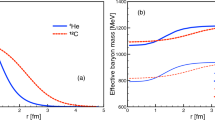Abstract
A model for solving the scattering problem by an axially symmetric potential has been developed. On the basis of this model, the interaction of the 238U isotope with a neutron has been studied. The correct accounting for the nonspherical shape of the uranium nucleus is accented. The optical potential has been used as the model. The spherically symmetric and nonspherical potentials are shown to result in different pictures of scattering, and, particularly, different resonance features of scattering. One of the directions of development of nuclear physics can be conditionally called extensive. Progress in the use of numerical methods leads to the necessity for the maximum possible account of all possible aspects of nuclear interactions, already known in principle. Relatively recently, the possibility of considering the nonspherical form of the nuclear interaction has been included in the software packages that allow calculating nuclear reactions, along with other necessary components [1, 2]. In the former work, the calculation of the interaction is based on the use of the TDHF approximation [3], in the latter, on the use of classical trajectories. On the one hand, the effect of nonsphericity is included in the code packages, while on the other hand, the calculation of the interaction is based on approximate, sometimes not even quantum-mechanical, schemes. In this study, we treat new effects arising from scattering by a nonspherical potential in the framework of quantum mechanics. As an example, one of the widely used reactions of nuclear power energetics was chosen—the interaction of a neutron with the nucleus of uranium-238. The interaction is described using an optical potential, which is one of the most popular simple potentials.



Similar content being viewed by others
REFERENCES
A. S. Umar and V. E. Oberacker, ”Time dependent Hartree–Fock fusion calculations for spherical, deformed systems,” Phys. Rev. C 74 (2), 024606 (2006).
V. V. Saiko and A. V. Karpov, “Analysis of multinucleon transfer reactions with spherical and statically deformed nuclei using a Langevin-type approach,” Phys. Rev. C 99, 014613 (2019).
J. A. Maruhna, P.-G. Reinhard, P. D. Stevenson, and A. S. Umar, “The TDHF Sky3D code,” Comp. Phys. Comm. 185, 2195–2216 (2014).
O. F. Nemets and Yu. V. Gofman, Nuclear Physics Handbook (Naukova Dumka, Kiev, 1975) [in Russian].
A. V. Yushkov, ”Surface of β(Z, N) nuclear deformation for nuclei with Z = 2–102,” Fiz. Elem. Chastits At. Yadra, 24, 348 (1993).
Yinlu Han, Yongli Xu, Haiying Liang, Hairui Guo, and Qingbiao Shen, “Global phenomenological optical model potential for nucleon-actinide reactions at energies up to 300 MeV,“ Phys. Rev. C 81, 024616 (2010).
P. M. Krassovotskiy and F. M. Pen’kov, “Determining the scattering amplitude in a limited computational domain,” Izv. Akad. Nauk Ser. Fiz. 83, 469 (2019).
P. M. Krassovotskiy and F. M. Pen’kov, “Asymptotic behavior of solutions in finite-difference schemes,” Izv. Akad. Nauk Ser. Fiz. 82, 1 (2018).
ACKNOWLEDGMENTS
A significant part of the calculations was performed on the JINR HYBRILIT cluster.
Funding
The work was supported in part by a grant of the Plenipotentiary Representative of the Republic of Kazakhstan at JINR, project no. 391 of 20.07.2020 and by the grant no. BR09158499 (Development of complex scientific research in the field of nuclear and radiation physics on the basis of Kazakhstan accelerator complexes) of the Ministry of Energy of the Republic of Kazakhstan. .
Author information
Authors and Affiliations
Corresponding author
Ethics declarations
The authors declare that they have no conflicts of interest.
Additional information
Translated by G. Dedkov
Rights and permissions
About this article
Cite this article
Krassovitskiy, P.M., Pen’kov, F.M. Features of Scattering by a Nonspherical Potential. Phys. Part. Nuclei 53, 247–250 (2022). https://doi.org/10.1134/S1063779622020447
Received:
Revised:
Accepted:
Published:
Issue Date:
DOI: https://doi.org/10.1134/S1063779622020447




